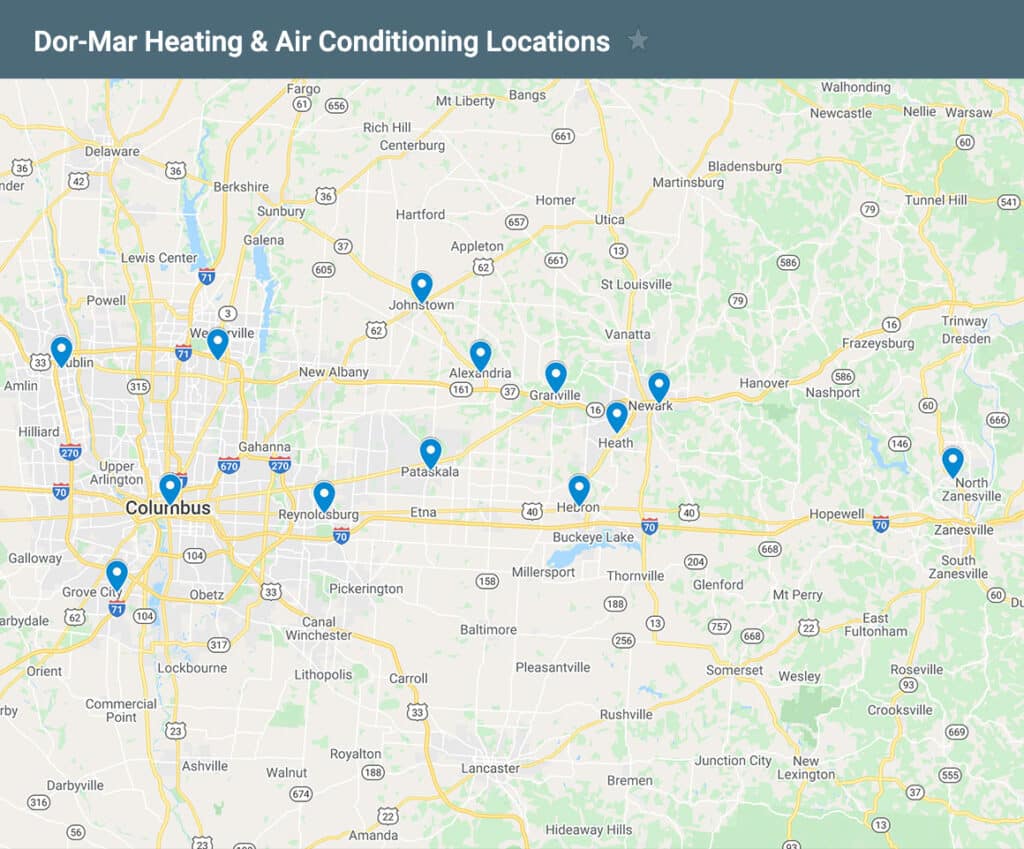Search on this page for commonly used HVAC terminology to help you better understand your Dor-Mar service technician or replacement estimate.
Click an item in the list to jump to that item below.
ACCA | Air Conditioner | Air flow | Air handler or air handling unit | Annual Fuel Utilization Efficiency (AFUE) | Boot | British Thermal Unit (BTU) | Capacitor | Checking the charge | Coil | Compressor | Condenser | Controller | Delta T (ΔT) | Evaporator | Furnace | Grille | Heat Exchanger | Heat pump | High Efficiency | HVAC | Latent heat | Line set | Load calculation | Media air cleaner | MERV | Plenum | Refrigerant | Refrigeration cycle | Register | Return | SEER | Split system | Standard Efficiency | Static Pressure | Supply | Thermostat | Tons of air conditioning or tonnage | Trunk | Two-stage | Zoning System |
| TERM | DESCRIPTION |
|---|---|
| ACCA |
A major trade association for the HVAC industry, the Air Conditioning Contractors of America. |
| Air Conditioner |
An appliance designed to dehumidify and extract heat from a home or office, leaving the remaining air cooler. |
| Air flow |
The volume of air your duct system moves. In general, air conditioners are designed to move about 400 cubic feet per minute (cfm) for each ton of air conditioner capacity. In humid climates, the number will be slightly lower (350cfm/ton), but in drier climates, will be slightly higher (500 cfm/ton). |
| Air handler or air handling unit |
A large metal box, part of the indoor unit for a furnace/AC system that contains the blower and heating or cooling elements. Air handlers connect to the ductwork that distributes the cooled or heated air through the building, then returns it to the air handler. |
| Annual Fuel Utilization Efficiency (AFUE) |
The thermal efficiency measure of space-heating furnaces and boilers, a ratio of useful energy output compared to energy input, expressed as a percentage. Typically used to measure the efficiency of a furnace, expressed in range from 80% for “standard” efficiency to 90% or higher for “high” efficiency furnaces. |
| Boot |
The section of shaped sheet metal that transitions the duct on one end to the grille or register on the other end. |
| British Thermal Unit (BTU) |
One BTU is the energy required to raise one poud of water one degree Fahrenheit. In the USA the power of HVAC systems is expressed in BTU/hour. |
| Capacitor |
Also known as a “run capacitor”, it’s is a small, cylindrical component that sends power to the motor that powers an air conditioning system. It gives it the initial boost it needs to turn on and also provides continuous power for the motor to keep running |
| Checking the charge |
Measuring the pressure of the refrigerant of an AC system to determine if it contains the proper amount. |
| Coil |
Part of the air conditioner that performs heat transfer to air, mounted inside an air handler or ductwork. It’s usually cooled by circulating liquid coolant within it. |
| Compressor |
A device that raises the temperature and pressure of the refrigerant in an Air Conditioning system. It’s part of the condensing unit that is installed outside of the house. |
| Condenser |
A heat exchanger, part of the basic refrigeration cycle that removes heat from the HVAC system. The condenser is the “hot” side of an air conditioner or heat pump. |
| Controller |
The part of an HVAC system that controls all or part of the system, usually based on input from a thermostat. In modern furnaces and AC equipment, usually a printed circuit board that can be swapped out from the system. |
| Delta T (ΔT) |
Measurement of the change (delta) of the temperature of air moving through the evaporator coil. In a healthy AC system, you should get about a 20°F ΔT when the air flows through the cooling stage of the refrigeration cycle. |
| Evaporator |
Part of the basic refrigeration cycle that absorbs or adds heat to the system, usually to absorb heat from the air. The evaporator is the “cold” side of an air conditioner or heat pump. |
| Furnace |
Part of an HVAC system that adds heat to the air of a home. |
| Grille |
Register used primarily in return air vents that doesn’t contain any moving parts. |
| Heat Exchanger |
Part of an HVAC system that transfer heat from the hot parts of the system to the cold parts of the system. |
| Heat pump |
Following the same principles as an air conditioner, it moves heat from inside to outside in the summer months; in heating months or winter, it moves heat from outside a building to inside. |
| High Efficiency |
Based on the AFUE rating of a furnace, usually referring to a 90% or higher efficiency furnace. See AFUE. |
| HVAC |
Abbreviation for the general name to cover the field of Heating, ventilation, and air conditioning. Can be pronounced “H-vac” or spelled out as H-V-A-C. |
| Latent heat |
Heat that must be removed from the air to remove moisture. |
| Line set |
Tubing that connects the condensing unit to the evaporator coil or an air conditioner. The larger insulated tube is the suction line; the smaller, hotter, uninsulated tube contains the liquid. |
| Load calculation |
The process of determining the proper size of an air conditioner and/or furnace for a home. Just one part of the HVAC design process. |
| Media air cleaner |
More efficient air filters for an HVAC system, constructed of materials that catch smaller particles passing through the duct system. |
| MERV |
A rating for filters used in HVAC system. The higher the Minimum Efficiency Reporting Value of a filter, the more particles it catches, and the more restrictive the airflow. |
| Plenum |
The (usually) sheet metal box connected to either side of an HVAC system’s air handler. On the supply side usually contains the evaporator coil (aka “a-coil”); on the return side, usually includes an air filter to filter return air before it re-enters the air handler. |
| Refrigerant |
The coolant that does the workload of modern air conditioner systems. Most newer systems use R-410a (aka Puron); older systems may use R-22, aka Freon, a hydrochlorofluorocarbon/HCFC that has been phased out of production as of Jan 1, 2020 due to concerns that it may cause holes in the ozone layer of the Earth. While it’s still available, the price is expected to increase sharply because of its relative scarcity. |
| Refrigeration cycle |
The cycle that allows an air conditioner to transfer heat from inside and send it outside, using a compressor, condenser and refrigerant. |
| Register |
Cover for a heating or air conditioner grate inside a home. Usually has moveable louvers that allow the homeowner to control the direction and amount of air flow. |
| Return |
The section of an HVAC ductwork system that “returns” air from the house back to the air handler to be conditioned again. Return vents usually have louvers but no moveable parts, and draw air in to the wall. May also be referred to as a “cold air return.” |
| SEER |
Seasonal Energy Efficiency Ratio measures air conditioning and heat pump cooling efficiency. The number stands for BTU/Hour of cooling, divided by electricity input in watts, and averaged over an entire cooling season. Ranges in values from 13 SEER to up to 22 SEER. |
| Split system |
An air conditioning system that includes an indoor unit (air handler and evaporator coil) and an outdoor unit (the condensing unit) connected by the lineset/coolant lines. |
| Standard Efficiency |
Refers to the AFUE rating of a furnace, typically in the 80% range. See High Efficiency. |
| Static Pressure |
The pressure inside a home’s ductwork system. Unfortunately, many HVAC contractors fail to check it, but it has a big effect on the efficiency and effectiveness of an air conditioner system. |
| Supply |
The part of a home’s duct system that moves conditioned air into the living space from the furnace or AC. When the heat or AC is turned on, the supply vents or registers have air coming out of them. |
| Thermostat |
A system that monitors and regulates an HVAC system. Typically installed on the wall in a home’s living room to provide heating and cooling temperature control for an entire house. Most newer thermostats are electronic, and allow the homeowner some ability to schedule or program temperature changes in the home. Some newer thermostats allow remote temperature control via a mobile app and/or use artificial intelligence to determine when to heat or cool a home. |
| Tons of air conditioning or tonnage |
The capacity of an air conditioning system. One ton of AC capacity equals 12,000 BTU/hour. For example, a 3-ton air conditioner can remove 36,000 BTU from a home if it runs for an hour. |
| Trunk |
A large piece of ductwork that attaches directly to the plenum that contains all the branches out to a house’s vents. |
| Two-stage |
A two-stage air conditioner is designed to operate on high and low settings during different seasons. The high setting is used during extreme warm weather, and the low setting during more moderate temperatures. This type of air conditioning system produces a balanced temperature and is in use for a longer period of time. |
| Zoning System |
Typically used in larger homes, it divides the structure into sections or zones which may be controlled independently of each other. Each zone is controlled by a different thermostat. |



